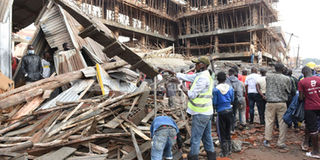KCCA orders developer to raze Kisenyi building

The building in Kisenyi, Kampala, which collapsed recently, leaving six dead and others injured. PHOTO/FILE
What you need to know:
- KCCA will proceed to demolish the structure with guidance from their directorate of legal affairs if the developer defies the alternative notices.
Kampala Capital City Authority (KCCA) has served notice to the owner of the partially collapsed Kisenyi building to raze it down.
The structure, owned by Mr Harunah Ssentongo, partially caved in a fortnight ago, leaving at least six people dead and five injured.
“[The notice] was issued on Friday and I am yet to confirm whether the developer (Mr Ssentongo) has received it,” KCCA spokesperson Daniel Nuwabiine said yesterday.
“It is a removal notice which means that the remaining structure must be removed. But we will only start counting the three days after he has received the notice,” he added.
Mr Ssentongo had written to KCCA’s physical planning directorate last week seeking permission to continue with construction of the remaining structure.
Mr Nuwabiine said a structural integrity assessment which was conducted by KCCA technocrats found the remaining structure unable to withstand more weight.
Mr Ssentongo couldn’t be reached for a comment yesterday.
Attempts to speak to his brother, Mr Hamis Kiggundu, last week were also unsuccessful.
Last option
Mr Nuwabiine, however, said the city authority will use alternative services such as newspapers and radio announcements to notify Mr Ssentongo.
KCCA will proceed to demolish the structure with guidance from their directorate of legal affairs if the developer defies the alternative notices.
Findings from the investigations conducted by the National Building Review Board on the collapsed building show that Mr Ssentongo used poor quality construction materials.
The poor quality of concrete and steel reinforcement is reported to have resulted in weak structural members that couldn’t support the applied loading.
“The average compressive strength of the concrete used in the construction was found to be less than 3 MPa, which is about 15 per cent of minimum concrete strength expected for such a building,” the report states in part.
“In addition, the yield strength of 16 mm diameter steel reinforcement which were used in the columns, and some beams was found to be lower by up to 36 percent from the required strength of 500 MPa,” it adds.
The report was particularly critical of the work on the fourth level, noting that “the foundations were not tied together by any ground beams, were not backfilled, and the ground floor slab was not constructed.” It added that “this exposed the supporting soil to excessive moisture, weakening the foundations.”





